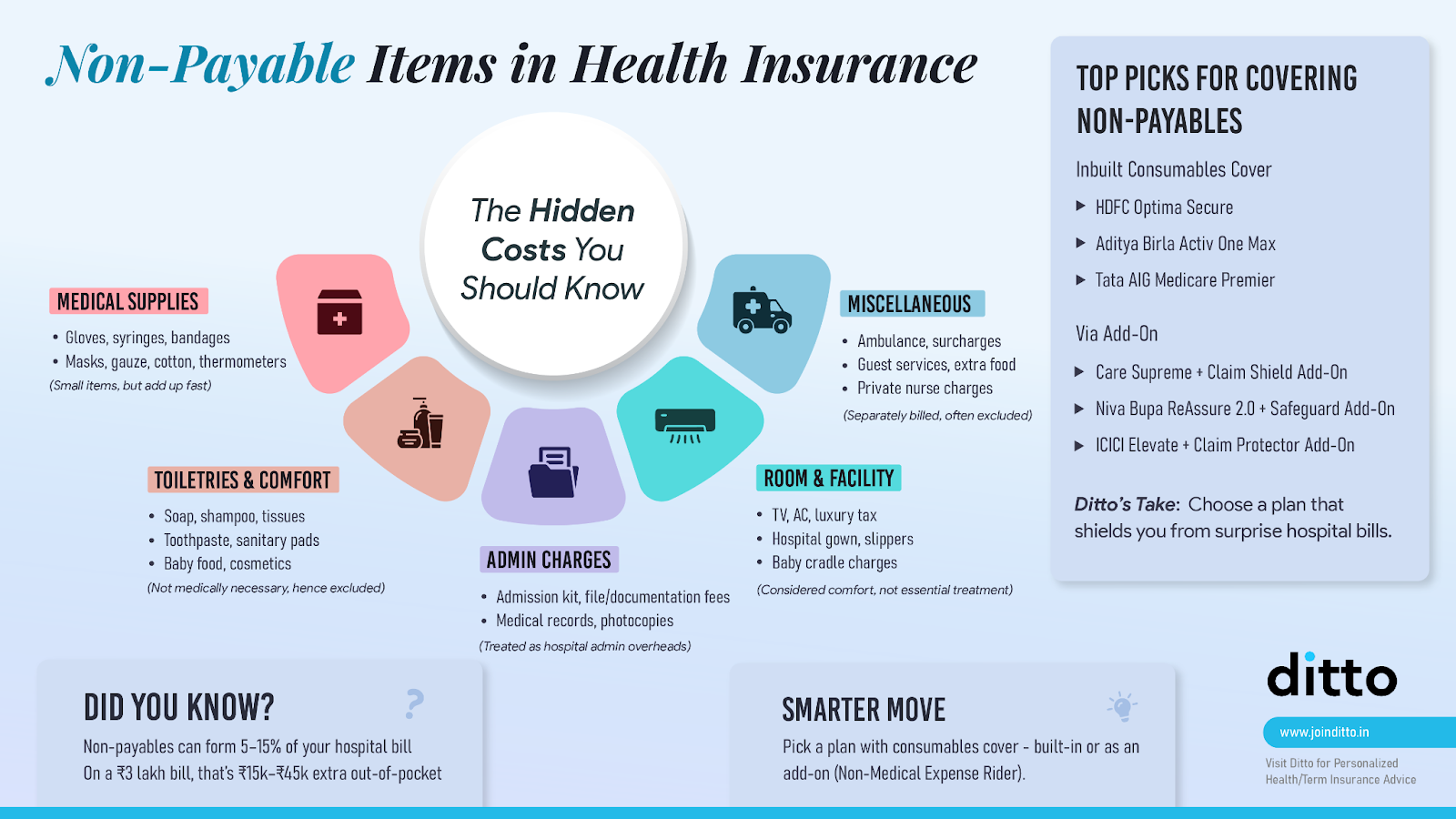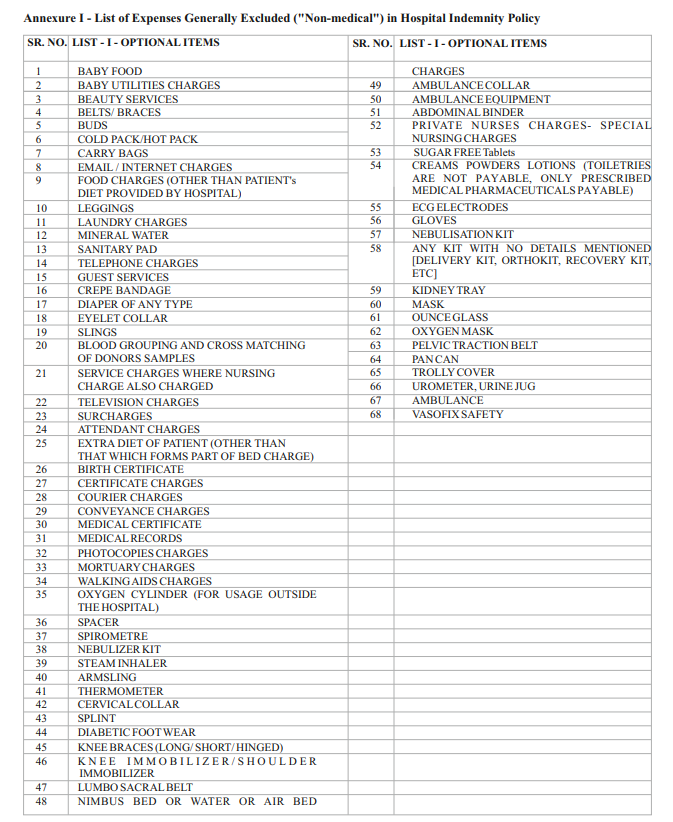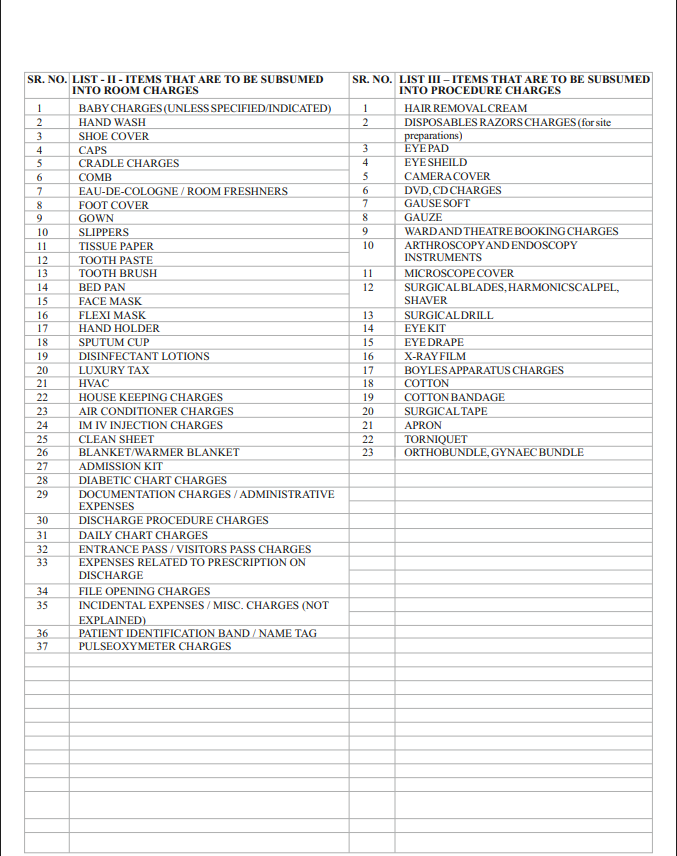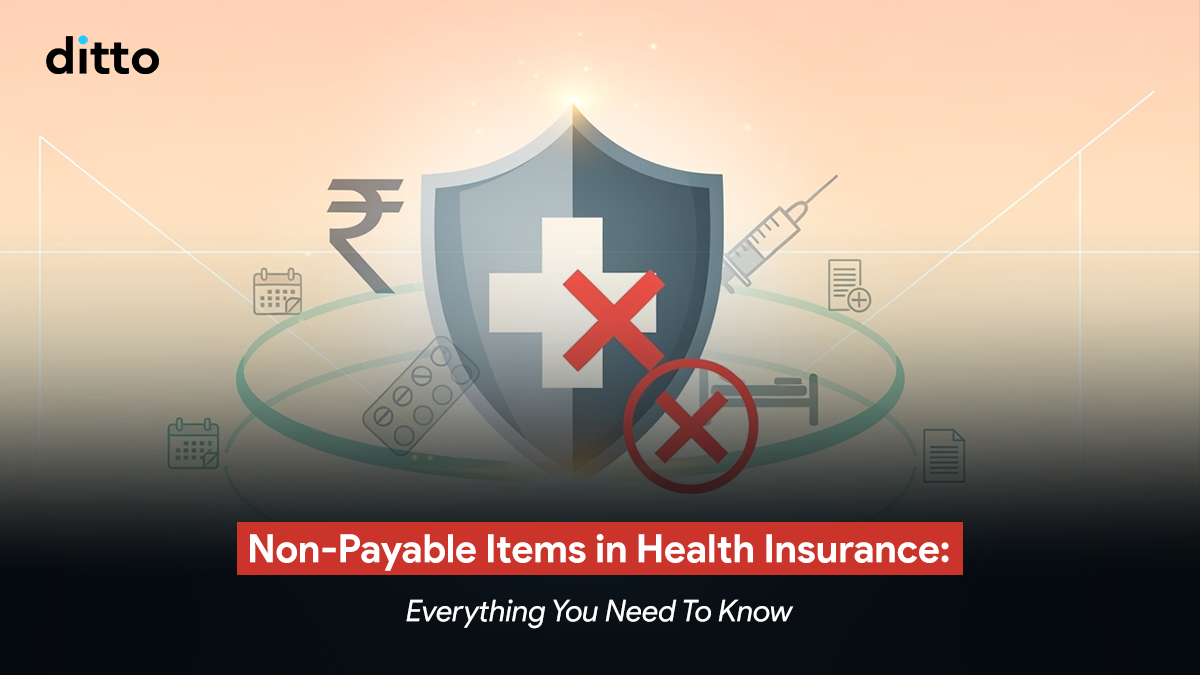| What Are Non-payable Items in Health Insurance? Non-payable items in health insurance are hospital expenses that policies do not cover or reimburse. According to IRDAI, non-payable items include consumables (like cotton, gloves, and syringes), hospital service charges, personal items (like toiletries), and non-returnable equipment (like oxygen masks). These items, in general, form 5-15% of your hospital bills and are to be paid out of your pocket. |
Ever wondered why a ₹2 lakh surgery covered by health insurance still leaves you with a ₹20,000 bill?
A cashless claim doesn’t mean costless treatment, and that’s where the concept of “non-payable items in health insurance” comes in.
Many policyholders are left surprised when hospitals ask them to pay extra for charges not covered by insurance. These are costs insurers consider “non-essential to treatment,” such as gloves, cotton, or admission fees.
At Ditto, our advisors frequently receive queries about “non-payable items in health insurance” adding to hospital bills. So, it makes sense to have a comprehensive understanding of the matter. Here’s your ultimate guide on non-payable items in health insurance, related IRDAI guidelines, different categories, and ways to minimize out-of-pocket expenses.
Book a free call with Ditto’s IRDAI-certified advisors to pick the right health insurance plans that cover non-payable items.
Real-World Impact Of Non-Payable Items in Health Insurance
Non-payable items are generally smaller exclusions that look trivial when viewed separately. But when calculated together, they form a substantial chunk of your hospital bill. Here are some glaring stats.
- On average, non-payable items in health insurance forms 5–15% of total hospital expenses.
- For surgeries costing ₹2,00,000 and above, an individual pays around ₹15,000–₹25,000 extra from his pocket for non-payable items.
- During the COVID-19 pandemic, PPE kits and other ICU consumables added no less than ₹3,000–₹7,000 per day to the hospital bill.
For families with limited liquidity, this additional cost is a hidden trap.
But why are these costs excluded in the first place? Insurers have three main reasons:
- Preventing Overbilling: It’s likely that hospitals inflate consumables or add unnecessary items. So, by not covering it, insurers prevent misuse.
- Premium Affordability: Covering every little consumable can translate to higher premiums and, therefore, can be unaffordable for many.
- Treatment Focus: The primary target of health insurance is to cover the expenses of treatment and not the administrative overheads or comfort items.
IRDAI Guidelines on Non-Payable Items in Health Insurance
The Insurance Regulatory and Development Authority of India (IRDAI) has standardised a list of 200+ non-payable items in health insurance. This benefits both parties; on one hand, insurers have a common point of reference, and on the other, policyholders aren’t left guessing what won’t be covered.
Most importantly, such benchmarks make billing a lot more transparent and protect customers from arbitrary exclusions by hospitals and insurers. However, insurers are free to offer add-ons to customers covering some exclusions.
In fact, many health plans now have in-built “consumables/non medical expense cover” that reimburses for the cost of syringes, gloves, PPE kits, and other items. This became more important after the COVID-19 pandemic.
Broad Categories of Non-Payable Items in Health Insurance
There’s more than one category for non-payable items in health insurance. Here’s a quick snapshot of common non-payable items one has to deal with during hospitalization.

The table below lists all broad categories with examples and reasons for exclusion.
| Non-payable Items Category | Examples | Why they are excluded |
|---|---|---|
| Consumables | Gloves, cotton, syringes, bandages, thermometers | Part of routine hospital supplies and too frequent items to reimburse separately |
| Administrative & Service Charges | Registration and admission charges, data handling and documentation | Counted as hospital overheads, not direct treatment costs |
| Personal items | Tissues, slippers, toiletries, water bottles, combs | For patient comfort or convenience, not medically necessary |
| Food & Beverages | All meals irrespective of the frequency | General meals are non-medical in nature; only doctor-prescribed diet for treatment may be payable |
| Non-Medical Equipment | Oxygen masks, external prosthetics, nebulizers | Reusable or durable equipment billed separately; excluded unless policy explicitly covers |
Here’s the complete list of individual items identified by IRDAI, included in room charges, procedure charges, and costs of treatment.



So, it's evident that even in a cashless hospitalisation, you can still be charged for the aforementioned items.
Want cashless benefits during hospitalisation? Check out our recommended cashless health insurance plans for 2025.
Non-Payable Items & Other Health Insurance Components
Non-payable items in health insurance are just a tiny part of the bigger picture. There are other important policy components to consider.
Room Rent Capping
If your health insurance plan caps room rent, other charges (doctor fees, nursing, ICU) also rise proportionally. That means, you not only pay for the remaining room rent but also the non-payables.
Say your total bill is ₹2,00,000, where:
- Non-payables = ₹20,000, and
- Payable heads = ₹1,80,000
You are eligible for a hospital room of ₹3,000/night, but the actual room rent is ₹5,000/night. The insurer applies a 60% cap ratio for a coverage of ₹1,08,000 (₹1,80,000 × 60%)So, your out-of-pocket expense will be ₹20,000 (non-payables) + 72,000/-(₹1,80,000 − ₹1,08,000) = ₹92,000/-
If the policy had no room rent restrictions, the insurer would have reimbursed the entire ₹1,80,000. That way, you would only pay ₹20,000 for non-payables!
Learn more about how room rent limits work in health insurance.
Co-payment This is where you pay a fixed percentage of the hospital bill, regardless of the coverage. So, non-payables will first raise your out of pocket expenses and then the co-pay further takes a cut from the remaining.
In the same example from above, if your policy has 10% co-pay, add ₹10,800 (10% of ₹1,08,000) which increases the out of pocket expenses to ₹1,02,800/-
If you’re a first-time health insurance buyer, here’s a must-read to understand how co-pay works in health insurance.
Sub-Limits
Sub-limits allow caps for certain procedures and treatments (e.g., cataract surgery). If the hospital charges more than the cap, the extra needs to be paid out of your pocket.
Let’s say your total hospitalisation bill for cataract surgery is ₹90,000/-, where:
- Non-payables = ₹5,000
- Payable heads =₹85,000,and
- Cataract sub-limit = ₹40,000
Here, the insurer pays ₹40,000 leaving you with an out of pocket expense of ₹50,000 (₹85,000 − ₹40,000) + ₹5,000)
Here’s an in-depth guide on disease-wise sub limits in health insurance to refer.
In any scenario, such policy conditions, together with the non-payables, significantly impact your out of pocket expenses.
Ditto’s Advice: Choose health insurance plans with a no room-rent limit, no co-pay, without sub-limits, and add a consumables cover.
Health Insurance Plans That Cover Non-Payable Items: Ditto’s Cut
Most people discover non-payable items in health insurance the hard way. That is when they’re billed for gloves, syringes, or admission files. A smarter move is to pick a health insurance plan that already covers such exclusions or choose an add-on.
Let’s take the example of a 30-year-old individual, living in a Tier-I city, opting for a ₹15L health insurance. Here’s an estimate of premiums listing top health insurance plans with cover for non-payable items, either inbuilt or via add-ons.
| Before we discuss the list, here’s how we decide what plans to feature. At Ditto, every health plan goes through our six-point evaluation framework. It doesn’t mean these are the only good plans, but that they stand out after being scored across all six pillars. You can learn more about how we evaluate health insurance plans here. |
Plans with in-built cover for non-payable items :
| Plan Name | Annual Premium |
|---|---|
| HDFC Optima Secure | ₹17,656 |
| Aditya Birla Activ One Max | ₹13,279 |
| Tata AIG Medicare Premier | ₹16,319 |
Plans covering non-payable items via add-ons :
| Plan Name | Add-on Name | Annual Premium (Without Add-on) | Annual Premium (With Add-on) |
|---|---|---|---|
| Care Supreme | Claim Shield | ₹14,454/- | ₹15,151/- |
| Niva Bupa Reassure 2.0 (Platinum) | Safegard Benefit | ₹15,216/- | ₹16,358/- |
| ICICI Elevate | Claim Protector | ₹11,160/- | ₹11,640/- |
Here’s how a Ditto customer paid just ₹697/- extra for Care Supreme’s Claim Shield add on and saved ₹45,000/- on consumables during his ACL reconstruction surgery.
His total cover was ₹10L and he spent 3 days in the hospital. The total bill incurred was ₹2,40,000 comprising of:
- Room/Nursing charges: ₹24,000
- OT/Surgeon charge: ₹1,05,000
- Medicines/Diagnostics: ₹28,500
- Implants (payable): ₹37,500
- Consumables (trocars/cannulas, shaver blades, sutures/tapes, hemostatic agents, disposable drill bits, sterile drapes, IV sets, syringes, etc.): ₹45,000
How the add-on helped:
The ₹45,000 consumables bucket was admitted under the add-on, doing away with the single biggest deduction.
The Outcome: With the add-on in place, the customer had to pay nothing out of pocket for the “consumables” part of the bill, and saved a good ₹45,000/-
Even if the insurer would've partly approved the claim, say like only 70% of consumables, he would’ve still saved ₹31,500/-
Why it matters:
Minimally invasive procedures like ACL reconstruction surgeries are always consumables-heavy. Therefore, adding a small add-on can save tens of thousands!
Need more info about these health plans, or want to know which plan suits your needs best? Book a call with Ditto and talk to our IRDAI-certified advisors right away!
| Key Takeaways: Cashless is not costless: You’ll still have to pay for non-payable items (consumables, admin/registration charges, comfort items, and non-returnable equipment) at discharge. The impact of non-payable items in health insurance is real: Non-payable items form 5–15% of your bill. If you run the math, that’s roughly ₹15k–₹25k out-of-pocket for a ₹2 lakh surgery! IRDAI has an exhaustive list of non-payable items. There are 200+ standardized non-payables and some insurers offer riders (e.g., consumables cover) to offset the costs. You can still reduce expenses: Pick the right health insurance plans and riders, get itemized bills, use corporate health insurance when available, and keep all receipts. Plan ahead: Before a hospitalisation, request a pre-authorization estimate with a list of likely non-payables. |
Why Choose Ditto for Your Health Insurance?
At Ditto, we have one common goal; to help you become a smart insurance buyer. To date, we’ve helped 7,00,000+ customers match their unique needs to the right health insurance policy.
There's more than one reason why customers trust Ditto and recommend us to others.

✅ Honest advice – no sales pitches, no commission-driven recommendations
✅ 12,000+ 5-star reviews (Rated 4.9 on Google)
✅ Real claim experience – we've helped customers through actual claims
✅ Backed by Zerodha and other leading fintech companies
Conclusion
While treatment coverage is of prime importance, non-payable items in health insurance shouldn't be ignored. Understanding non-payables, cross-checking IRDAI’s list, and selecting the right policy and add-ons can protect you from inflated hospital bills.
Need help finding the right health insurance plan with cover for non-payable items? Book a free call with Ditto and let our experts guide you.
FAQs:
Can I buy extra cover for non-payable items?
Yes, you can. Many insurers offer add-on covers that reimburse consumables and other service charges.
Are all consumables excluded?
Not always. If consumables are directly tied to treatment, for example a surgical implant, they can be covered.
How do I know in advance what I’ll need to pay for during hospitalisation?
You can request a pre-authorization estimate from your hospital and ask for a list of non-payables.
Do cashless claims also exclude non-payable items?
Yes! Even in cashless claims, the insurer will only settle the payable part, i.e., the actual treatment costs. The cost for all non-payables items is to be borne by the patient during discharge, unless one has a comprehensive health insurance plan covering them.
Which insurers cover the maximum number of non-payable items in health insurance?
Many new-age insurers cover non-payable items in health insurance like Care Health and Niva Bupa. But always compare the benefits before buying and match your individual needs.
Last updated on:










